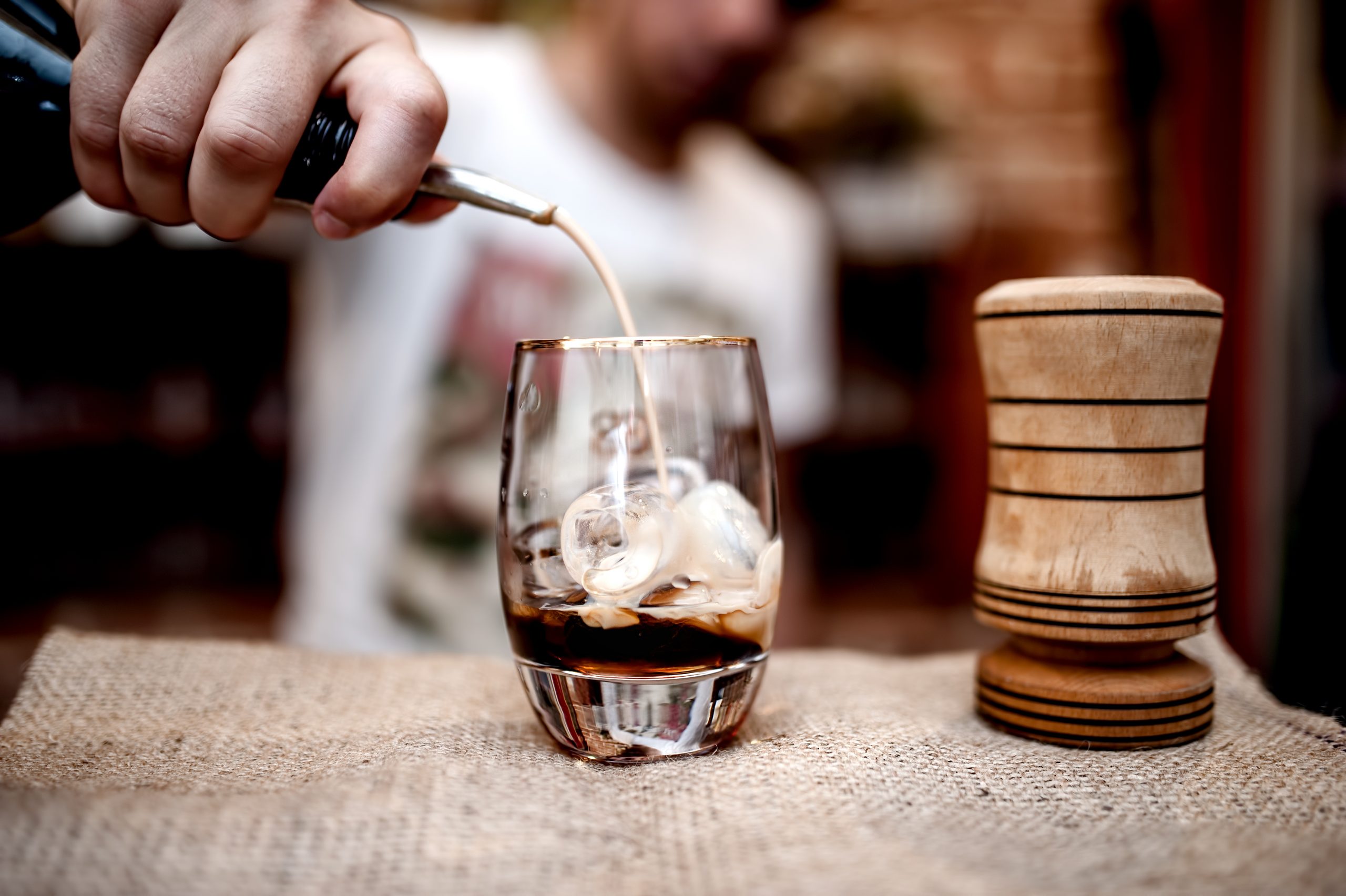


On the surface, pour spouts might not seem like a fascinating topic. But the type you use, your cleaning method, and the pour spout training you provide to your staff can affect your bottom line. Essentially, if you don’t put enough thought into pour spouts, you could be wasting a lot of money.
Start Your Free Trial With Bevspot Today!
Now do we have your attention?
If you work in the bar industry, you’re surrounded by pour spouts. They’ve been there for you since day one, on almost every bottle. You know that pour spouts are essential for speed and accuracy, helping you avoid over-pouring, spillage, and wasted time. If you’ve ever tried to pour without one, you’ve likely seriously botched a cocktail and wasted product.
Depending on your bar, they might all be shiny metal and rubber, a medley of plastic multi-colored spouts, or a combination of the two. When you need to replace one, you might simply swap it with whatever’s convenient. But what if this haphazard method is costing you money and wasting bar inventory?
You may not have thought about them critically before, but it’s time to get serious about pour spouts! Here are 10 types of pour spouts you need to know.
Technically, there’s no such thing as the “best pour spout.” If your bar is a high volume city sports bar, a quieter craft cocktail bar, or a divey college bar, you’ll likely have different priorities when it comes to pour speed, durability, appearance, and precision. We’ve compiled a list of common pour spouts and their different features.
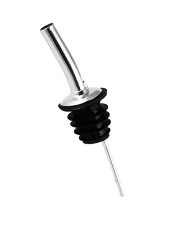
Price: $6-13/dozen
Very commonly used, the standard metal pourer helps bartenders prepare drinks with accuracy and speed. The long spout reduces spillage and allows for precise, high-flow rate pours. The standard metal pourer usually features a rubber seal. Keep in mind that it doesn’t include a built-in mechanism to prevent insect or dust contamination.
 2. Tapered Metal Pourer
2. Tapered Metal PourerPrice: $6 -13/dozen
A tapered pourer offers accuracy, control, and a consistent pour speed every time. It has a medium flow-rate and it usually has a rubber seal. Despite its popularity it is susceptible to fruit fly and other contaminants.
 3. Screened Metal Pourer
3. Screened Metal PourerPrice: $10-25/dozen
This pourer is not as commonly used. It has a lower flow rate sometimes about ½ to ⅔ the rate of standard pourers. The screen can make it difficult to pour more syrupy or creamy spirits such as Kahlua, Chocolate Liqueur, or Midori. If pourers slow you down, they can cost you money. Bartenders also often report that the screens sometimes fall out into customers’ drinks, they’re also a bit difficult to clean. The good news about screened metal pourers is they’re impervious to insects. If you use these spouts, put them on infrequently used sweet liqueurs that might be especially attractive to bugs.
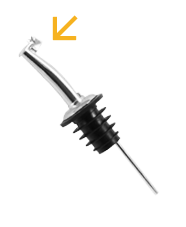 4. Metal Flap Pourer
4. Metal Flap PourerPrice: $8-20/dozen
If you’re looking to keep out debris and bugs, a pour spout equipped with a built-in flap might be the way to go. For the most part, users have reported no effect to the pour speed. However, some thicker, stickier spirits can sometimes get stuck on the flap and slow the pour. Some flaps open automatically when you tilt the bottle down and others need to be manually opened with your thumb.
** Note: metal pourers are widely deemed the “best looking” pour spouts for presentation of alcohol behind the bar
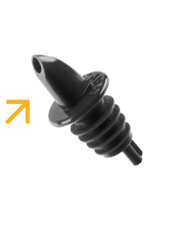
Price: $2-6/dozen
Plastic pourers come in a variety of colors and are usually the cheapest type of pourer. Since they’re made using one piece of molded plastic, they can be pretty durable. These pourers are very common behind the bar. They generally perform well but tend to “hiccup” if you turn them upside down too quickly to pour. With plastic pourers, you have the ability to choose from a variety of colors. Some bars go for the more “professional look” by putting the same colored spouts on every bottle. Others use the color nozzles to help bartenders quickly identify alcohol types or they choose to mix and match colors randomly. As a reminder, these are not screened so they are susceptible to contamination.
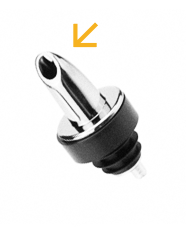
Price: $7-13/dozen
Many bartenders prefer this type of pourer for its look and control. This pourer features a longer nozzle and a larger hole for a fast pour speed. To slow down the flow rate, you can use your thumb to cover the breathing hole. This type of pour spout is also easy to clean but does not include a mechanism for keeping bugs at bay.
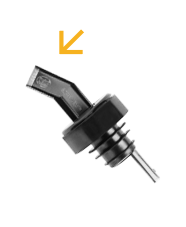
Price: $3-12/ dozen
If your goal is to keep out the fruit flies but still retain a fast pour speed, a screened plastic pourer might be your best bet. You can also purchase them in a variety of colors! On the flip side, they need to be cleaned frequently and they’re not very well suited for thicker syrupy spirits such as Bailey’s Original Irish Cream. Controlling the speed of the pour can also be difficult because there is no separate vent.
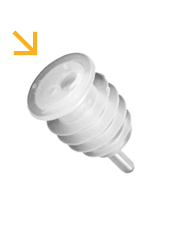
Price: $0.79/dozen
Another way to avoid evaporation and contamination is to use Cap-OnⓇ Liquor Pourers. These pourers have great accuracy and because they’re leveled off, you can still store your liquor with the cap on. The company suggests you throw out the pourer with each emptied bottle, but some bartenders explain they can get them out and recycle them with a V-RodⓇ bottle opener. Warning, some bartenders report that the cap will not go back on for certain liquors with shorter caps such as Maker’s Mark if this pourer is used.

Price: $25-50/dozen
Although the idea is headed in the right direction, precision ball pourers often get a bad rap among bartenders. They’re designed to allow pours of 1oz to 1.5oz to administer strict quantity control in order to reduce liquor costs and provide consistency. This might be a decent method for pouring with precision and keeping track of what leaves the bar and it can prove useful in alcohol tastings. Using a ball pourer also allows bartenders to use both hands so they can be pouring in the mixer and the liquor at the same time, which saves time. Sounds great right? That’s not always the case. Moving to these pourers might make bartenders feel like management doesn’t trust them, and ball pourers can restrict bartenders from pouring a “dash” or a “splash” when a cocktail recipe calls for it.
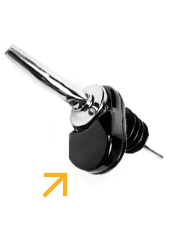
Price: Usually need to request a quote (tend to be pretty expensive)
Computerized pourers either distribute a certain amount like ball pourers or they free pour. Regardless of the pour method, the computer pourer provides extremely strict inventory control, calculating, and consecutive reporting. Usually, these pourers are linked wirelessly to the POS or another digital system so there can be real-time analysis. Although these might seem like a smart way to decrease liquor spend and keep track of data, it’s important to keep in mind that some bartenders feel these are invasive and overbearing. Also, when customers see a computerized pourer used behind the bar, they might feel like the experience isn’t as authentic or personal.
Pour spouts are supposed to allow for a smooth, even pour, but if the air vents become blocked, liquid won’t come out of the bottle. Over time, pour spout vents can get clogged, especially those used to pour liquor with high sugar content. To keep your pour spouts working their best and to help them last longer, you should clean and check for/replace broken ones regularly. If you need to clean them, there are a number of different ways.
Some pour spout companies such as Precision Pours suggest you use a special $45-$50 pour spout cleaner that only uses warm water and eliminates the need for soaking or using detergents.
If you don’t want to purchase a new tool you can soak your spouts in warm, soapy water for 15-20 minutes. In order to wash the inside of the spouts, shake them to get the soapy water inside and conclude your wash by rinsing them in cold water. Be sure to avoid using sanitizers and bleaches, dishwashers, and overly hot water.
Many bartenders report that metal pour spouts tend to pour at the same rate, but plastic ones don’t have the same consistency. Ball pourers, if quality, will automatically measure one ounce. The bottom line is different pour spouts have different pour rates. It’s important to keep in mind that no matter what pour spout you choose to put on your bottles, your staff needs to be trained on how to use them (especially if they’re free pouring without a jigger).
In order to learn how to properly pour an ounce, bartenders should practice pouring an ounce into a one-ounce jigger or a one ounce marked glass using some type of counting system. Depending on their preference or the type of pour spout they use, they might want to count to either three or four (the most common method) per ounce or they can make up their own counting scheme – as long as it works!
In order to ensure bartenders’ free pours are accurate and consistent, avoid switching out pour spouts once you’ve chosen the right one for your bar, and you’ve trained your staff. If you randomly change out pour spouts with whatever is the cheapest or most easily available, your bartenders might take a while to get used to the pour speed, or worse yet, they might continuously overpour without either of you knowing it. Even if you don’t switch up pour spouts, if your bartenders are free pouring, they should be frequently tested to see if their pours are accurate.
As you can see, pour spouts are more than meets the eye. You want them to look good, work properly, and pour consistently. Carefully consider which pour spouts will work best for your bar, be sure to constantly clean them, and properly train your staff how to pour one ounce every time. For more helpful bar management tips, check out our ebook!
Schedule 15mins to chat with a product specialist
Start a FREE Trial Today! BevSpot offers full product education and account setup for all customers! No card Information needed!
